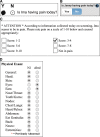Prevalence of pain reports in pediatric primary care and association with demographics, body mass index, and exam findings: a cross-sectional study
- PMID: 30463543
- PMCID: PMC6247700
- DOI: 10.1186/s12887-018-1335-0
Prevalence of pain reports in pediatric primary care and association with demographics, body mass index, and exam findings: a cross-sectional study
Abstract
Background: Pediatric pain is associated to patient weight and demographics in specialized settings, but pain prevalence and its associated patient attributes in general pediatric outpatient care are unknown. Our objective was to determine the rate of positive pain screenings in pediatric primary care and evaluate the relationship between reported pain and obesity, demographics, and exam findings during routine pediatric encounters.
Methods: Cross-sectional observational study of 26,180 patients ages 2 to 19 seen in five urban pediatric primary care clinics between 2009 and 2016. Data were collected from systematic screening using a computerized clinical decision support system. Multivariable logistic regressions were used to analyze the association between pain reporting and obesity (body mass index), age, sex, race, season, insurance status, clinic site, prior pain reporting, pain reporting method, and exam findings.
Results: Pain was reported by the patient or caregiver in 14.9% of visits. In adjusted models, pain reporting was associated with obesity (Odds Ratio (OR) 1.23, 95% Confidence Intervals (CI) 1.11-1.35) and severe obesity (OR 1.32, CI 1.17-1.49); adolescents (OR 1.47, CI 1.33-1.61); and females (OR 1.21, CI 1.12-1.29). Pain reported at the preceding visit increased odds of pain reporting 2.67 times (CI 2.42-2.95). Abnormal abdominal, extremity, ear, nose, throat, and lymph node exams were associated with pain reporting. Pain reporting increased in minority races within clinics that predominantly saw a concordant race.
Conclusions: Pain is common in general pediatric encounters, and occurs more frequently in obese children and those who previously reported pain. Pain reporting may be influenced by seasonal variation and clinic factors. Future pediatric pain screening may be guided by associated risk factors to improve identification and targeted healthcare interventions.
Keywords: Ambulatory care; Clinical decision support; Obesity; Pain.
Conflict of interest statement
Authors’ information
AC and SM are co-creators of the CHICA clinical decision support system, which was developed at Indiana University, a non-profit state university.
Ethics approval and consent to participate
The study protocol (#1205008710) was approved by the Indiana University Institutional Review Board, and included a waiver of informed consent because no interventions were being implemented, impracticability, and minimal risk.
Consent for publication
Not applicable.
Competing interests
In 2016, SD co-founded a company to disseminate the CHICA technology. AC is a co-inventor of CHICA. There is no patent, and at this time, there is no licensing agreement. The other authors declare that they have no competing interests to disclose.
Publisher’s Note
Springer Nature remains neutral with regard to jurisdictional claims in published maps and institutional affiliations.
Figures
References
-
- Knapp DA, Koch H. The management of new pain in office-based ambulatory care: National Ambulatory Medical Care Survey, 1980 and 1981. Adv Data. 1984;97:1–9. https://www.ncbi.nlm.nih.gov/pubmed/10266817. - PubMed
Publication types
MeSH terms
Grants and funding
LinkOut - more resources
Full Text Sources
Medical



